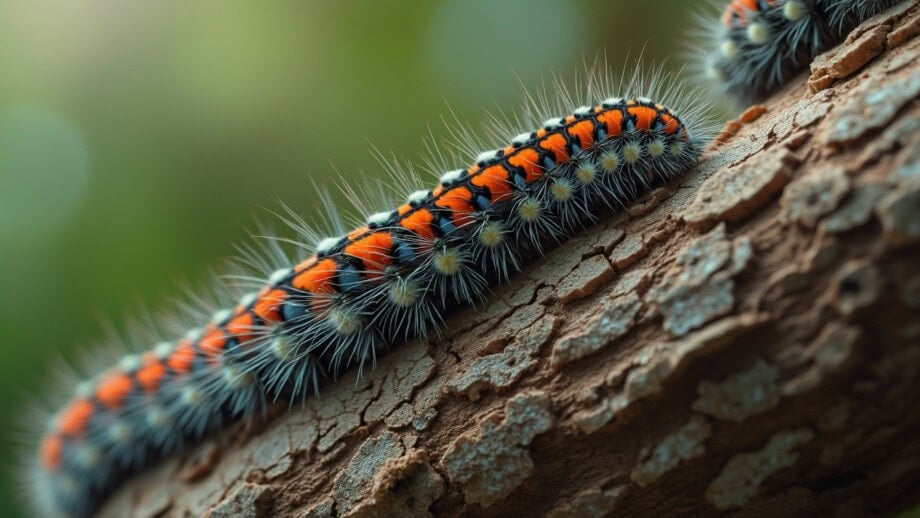How to Get Rid of Spongy Moths (Formerly Gypsy Moths)
A major pest of hardwood trees, gypsy moth control is often necessary to prevent damage in backyards and many urban areas.

Spongy moth caterpillars (formerly known as gypsy moth caterpillars) are a major pest of hardwood trees and control is often necessary to prevent damage in backyards and many urban areas.
This invasive pest made its way to the United States from Europe and has now, unfortunately, spread across much of the Northeastern parts of the country, and even Canada.
They cause significant defoliation annually and the USDA Forest Service has had a leading role in treating areas with high populations.
If you suspect that spongy moth caterpillars (gypsy moth caterpillars) have started invading your backyard, it’s time to take some action! Learn exactly what they are, how to identify them, and what to do to effectively control these invasive pests in this article.
Gypsy Moth (Lymantria dispar) is Now Called Spongy Moth
Gypsy Moth (Lymantria dispar) now has a new common name and is called the Spongy Moth. The name was officially changed by The Entomological Society of America (ESA) as part of their Better Common Names Project.
The name was first proposed in late 2020 and then in March 2021, the name was officially changed. This new policy now bars common names from referencing ethnic or racial groups.
This is a great step forward that Planet Natural supports, and so we want to be part of providing information regarding this change. For this reason, we’ll be referencing both names in this article currently and will transition it out as more and more people are aware of the change.
What is a Spongy Moth?
The spongy moth (Lymantria dispar) is a non-native insect from Europe. It was previously known as the gypsy moth before the name was officially changed by the Entomological Society of America (ESA) in March 2021.
It feeds on the leaves of a wide variety of trees, including oak, maple, apple, crabapple, hickory, basswood, birch, aspen, willow, pine, hemlock, and more.
Oak trees are its preferred host, and this pest has unfortunately naturalized in many forests around the US because of which it will always be found there.
When Was Spongy Moth Introduced Into the U.S.?
In the mid-1800s, spongy moth larvae (gypsy moth larvae) that were being evaluated for silk production were blown from a window sill in Medford, Massachusetts. The first outbreak of gypsy moth occurred in 1889.
By 1987, the spongy moth had established itself throughout the Northeast and is now found throughout much of the Eastern United States. It is one of the most damaging pests of hardwood forests and urban landscapes, defoliating a million or more forested acres annually.
Spongy moths (gypsy moths) are spread over large areas primarily by shipment of infested nursery stock or any object on which eggs may be deposited.
How to Identify Spongy Moth (Formerly Gypsy Moth)?
The easiest way to identify spongy moths is by recognizing their characteristic dots. Only the caterpillar stage of the spongy moth feeds.
When fully grown, they will be approximately 2 inches long, very hairy, and have five pairs of blue dots followed by six pairs of red dots along their back. This is the easiest way to identify them and what differentiates spongy moth caterpillars from other pests.
Adults are gray (male) or white (female) colored hairy moths with a 1-1/2 – 2 inch wingspan. Although both sexes are winged, the female moth does not fly.

Life Cycle of a Spongy Moth (Previously Called Gypsy Moth)
The female spongy moth (gypsy moth) lays an egg mass, covering it with body hairs to act as insulation and to help protect the eggs from predators. Shortly after the female spongy moth (gypsy moth) lays the egg mass, she dies, and the eggs wait out the winter until temperatures rise in the spring and a hatch begins.
Upon hatching, small black-headed spongy moth caterpillars (gypsy moth caterpillars), climb to the tops of the trees where they may begin to feed on foliage or they may dangle from silk strands and drift in the wind to colonize other trees.
Spongy moth caterpillars (gypsy moth caterpillars) go through five or six instars and feed from late April to mid-June. Most of the feeding occurs at night to protect caterpillars from extreme heat and predation by birds during the day.
When fully mature, caterpillars stop feeding and change into pupae. Adult moths emerge 7-10 days later. There is one generation per year.
Cyclical Outbreaks of Spongy Moth Caterpillars
Spongy moth caterpillar populations vary in cycles over periods of approximately 10 to 15 years. This results in some years where the population is low and other years with high populations of caterpillars and significant tree defoliation and damage.
The primary reason for this is the interaction between predators and prey, namely spongy moth caterpillars in this case, and small mammals that consume them. It all depends on acorn production which drives small mammals to the forest when looking for food.
Acorn production is cyclical and varies from one tree to another. In some years when crops fail for all tree species at the same time, no acorns are produced. This leads to less food for small mammals that consume spongy moths and keep their populations in control.
Unfortunately, this means that when there aren’t enough mammals, spongy moth populations can grow and reach outbreak levels. However, a lack of acorns doesn’t mean that the populations will grow quickly.
Contrary to this, it may take up to three years for the mammal population to decline to reach an outbreak level. Natural disasters can also lead to an end to an outbreak. USDA Forest Service has had a leading role in treating areas with high populations.
How to Control and Get Rid of Spongy Moth Caterpillars (Formerly Gypsy Moth Caterpillars)
Clean Your Yard
Keep your yard as clean as possible. Remove discarded items, dead branches, stumps, etc., where the adult female moth is likely to lay egg masses. Destroy any egg masses that are found.
Use Traps and Barriers
The Gypsy Moth Trap is used to monitor the moth population and may also prevent male moths from homing in on females.
You can also use the Tanglefoot Pest Barrier and place it around tree trunks to help curtail the caterpillars’ movement into and out of the tree canopy.
Apply Bacillus thuringiensis var. Kurstaki (Btk)
Apply Bacillus thuringiensis, var. kurstaki (Btk), or Monterey Garden Insect Spray (Spinosad) to the leaves of trees to kill gypsy moth caterpillars.
For best results, sprays must be applied when caterpillars are young, less than one inch long, and are actively feeding as it is a stomach poison that needs to be injected to be effective.
In instances where populations are high, two (or more!) applications five days apart might be needed.
Use Horticultural Oils or Derivatives
AzaMax contains azadirachtin, the key insecticidal ingredient found in neem oil. This concentrated spray disrupts the growth and development of pest insects and has repellent and antifeedant properties. Best of all, it’s non-toxic to honey bees and many other beneficial insects.
Apply Insecticides
Insecticides should be used as a last resort after trying all other methods mentioned above. Botanical insecticides are derived from plants that have insecticidal properties. These natural pesticides have fewer harmful side effects than synthetic chemicals and break down more quickly in the environment.
Chemical insecticides are contact poisons, and so these chemicals can harm a variety of beneficial insects and pollinators such as bees, as well as nesting birds, and other wildlife. So use them with caution.
Spraying is ineffective against spongy moth pupae or egg masses, and it becomes even less effective once caterpillars reach an inch in length.

















